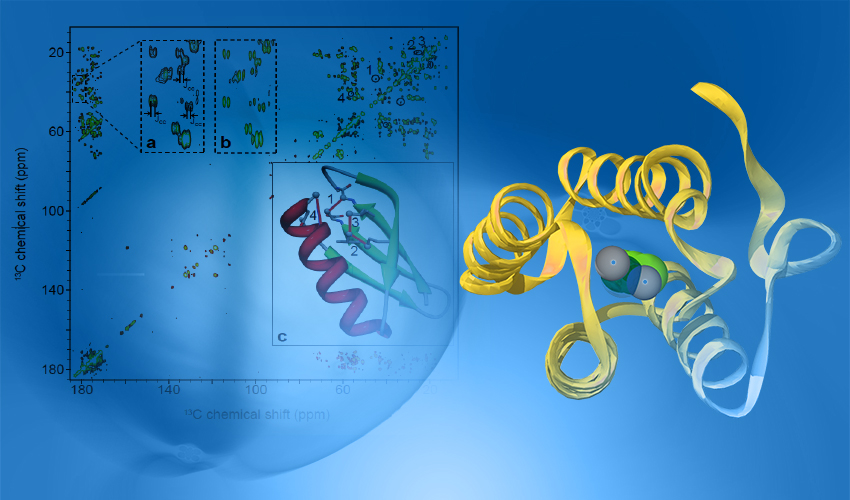

High-Field TROSY 15N NMR and Protein Structure
Nuclear magnetic resonance (NMR) spectroscopy is a powerful and versatile tool in the field of molecular biology, allowing researchers to examine the structure and conformation of proteins and macromolecules, establish mechanisms and carry out a range of functional studies.1
The value of TROSY NMR
Transverse relaxation-optimized spectroscopy (TROSY) is an NMR
technique used in combination with different isotope-labelling
techniques that has allowed researchers to study biomolecules of up to
1000KDa in solution. Some important recent uses of TROSY include: 2,3
- Structure determination of membrane proteins in detergent micelles
- Structural and functional studies of proteins in monomeric form and macromolecular complexes
- Investigations of intermolecular interactions in large complexes and intrinsically disordered proteins (IDPs)
TROSY is an NMR technique introduced in 1997 by Pervushin and
Wüthrich, which makes use of the cancellation between dipolar coupling
and chemical shift anisotropy (CSA), or alternatively between different
dipolar couplings to record signals with sharp peaks in macromolecule
complexes such as proteins, enzymes, DNA/protein complexes and
sub-units.4
The first TROSY experiments used the cancellation between N chemical shift anisotropy and the NH dipole with some success at the time, but because TROSY works better at high magnetic field strength it was limited to high field instruments. The TROSY experiment is actually best carried out at frequencies close to 1 GHz.4
New TROSY experiments
In the field of protein NMR the 15N nucleus has been
underused and side-lined possibly because of the low gyromagnetic ratio
(γ) of nitrogen and a perception of low sensitivity (15N has a -1/2 spin and a natural abundance of 0.00346-0.00421%).
However, in 2012 multi-nuclear experiments that can benefit from the slower relaxation properties of 13C and 15N were proposed to give more insight into the internal structures of proteins.5
Takeuchi et al showed in their 2015 paper, ‘Nitrogen detected TROSY at high field yields high resolution and sensitivity for protein NMR’ in the Journal of Biomolecular NMR, that TROSY 15N-H experiments certainly can provide high quality spectra in instrumentation with high field magnets.
The new TROSY experiments take advantage of slow 15N transverse relaxation (T2) and compensate for low sensitivity by using high magnetic field strength.
In these two dimensional (2D) 1H-15N experiments 15N provided high quality spectra following a 13 hour accumulation at 800 MHz (18 hour accumulation at 500 MHz).
The use of 15N detection means that the study of larger proteins and IDPs, which tend to suffer from severe spectral overlap is made significantly easier.6
In addition, unlike 1H TROSY, deuteration is not required and this allows a wider range of proteins to be studied such as those that can only be expressed in mammalian or insect cells or protein systems that cannot be refolded for amide back exchange (proteins can be expressed in a 1H environment with no detrimental effects on the 15N NMR).
Although 15N NMR is much less sensitive the quality of the 15N-1H spectra were close to that of 1H TROSY with narrower lines giving an added advantage for studying large proteins. This technique also has additional scope for 3D experiments which can be used for the backbone and side chain assignment of very large proteins.
Conclusion
TROSY is an extremely versatile NMR technique providing the
ability to improve the measurement of residual dipolar couplings and
even the detection of scalar couplings across hydrogen bonds.
TROSY promises to further enhance the determination of solution structures of both large proteins and oligonucleotides.
Often in the study of large proteins expressed in deuterated media there is a problem of incomplete amide proton back exchange, which hampers the detection of amide groups at the core of the protein.
With 15N TROSY deuteration is not necessary and so more and larger proteins can be studied successfully using this technique.
References
- Wagner G., (1997), An account of NMR in structural biology, Nature Structural Biology, 4 Suppl: pp841-844.
- Fernández C., Wider G. (2003), TROSY in NMR studies of the structure and function of large biological macromolecules, Curr Opin Struct Biol. Oct: 13(5): pp570-80.
- Xu Y., Matthews S. (2013) TROSY NMR spectroscopy of large soluble proteins, Top Curr Chem.;335: pp97-119.
- Pervushin K., Riek R, Wider G, Wüthrich K. (1997), Attenuated T2 relaxation by mutual cancellation of dipole-dipole coupling and chemical shift anisotropy indicates an avenue to NMR structures of very large biological macromolecules in solution. Proc Natl Acad Sci USA. 1997 Nov 11;94(23):12366-71.
- Takeuchi K, et al., (2012) Low gamma nuclei detection experiments for bimolecular NMR. In Clore M and Potts J., (eds) Recent Developments in Biomolecular NMR, Royal Society of Chemistry.
- Takeuchi K, Arthanari H, Shimada I, Wagner G. J (2015), Nitrogen detected TROSY at high field yields high resolution and sensitivity for protein NMR, Biomol. NMR, Oct 23


